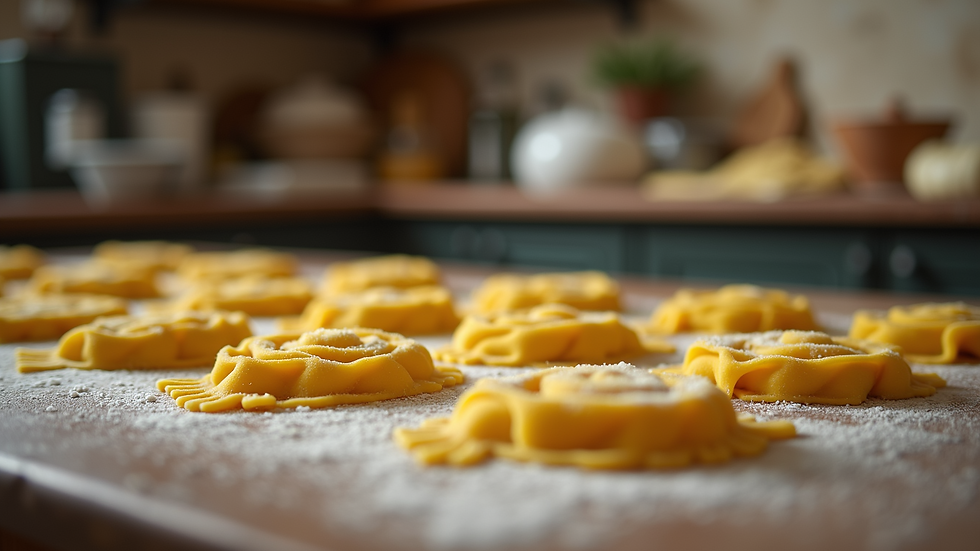The Evolution of Pasta in Italian Cuisine
- Glenda Kelly
- Sep 12
- 4 min read
Italian pasta is more than just a staple food; it is a symbol of culture, tradition, and culinary artistry. Over centuries, pasta has evolved from simple dough to a diverse array of shapes and recipes that define Italian cuisine worldwide. This article explores the fascinating journey of Italian pasta, its historical roots, regional variations, and the timeless recipes that continue to delight palates today.
The Origins and Early History of Italian Pasta
Pasta's history is rich and complex, with origins that trace back thousands of years. While some myths credit Marco Polo with bringing pasta from China to Italy, historical evidence suggests that pasta was already present in Italy long before his travels.
Ancient Beginnings: Archaeological findings indicate that ancient Etruscans and Romans made a form of pasta using durum wheat and water. This early pasta was likely a simple, flat dough cooked over fire.
Medieval Developments: By the Middle Ages, pasta had become a common food in southern Italy, especially in Sicily and Naples. The introduction of dried pasta allowed for longer storage and easier transportation, making it a practical staple.
Durum Wheat and Pasta: The use of durum wheat semolina, which is high in gluten, gave Italian pasta its distinctive firm texture. This innovation was crucial in shaping the pasta we know today.
The evolution of pasta was influenced by geography, climate, and trade routes, which helped diversify the types and preparation methods across Italy.

The Role of Italian Pasta in Regional Cuisine
Italian pasta is not a monolith; it varies significantly from region to region, reflecting local ingredients, climate, and culinary traditions.
Northern Italy: In regions like Lombardy and Veneto, pasta is often made with eggs and soft wheat flour, resulting in delicate shapes like tagliatelle and tortellini. Rich sauces with butter, cream, and cheese are common.
Central Italy: Tuscany and Umbria favor simple pasta dishes with olive oil, garlic, and fresh herbs. Pici, a thick hand-rolled pasta, is a regional specialty.
Southern Italy: The south, including Campania and Sicily, is famous for dried pasta made from durum wheat. Tomato-based sauces, seafood, and spicy flavors dominate here.
Each region’s pasta dishes tell a story of local culture and history, making Italian pasta a mosaic of flavors and techniques.

What are the 4 Original Italian Pastas?
Italian cuisine boasts a variety of pasta shapes, but four are often considered the originals due to their historical significance and widespread use:
Spaghetti - Long, thin cylindrical pasta that is versatile and popular worldwide.
Macaroni - Short, curved tubes often used in baked dishes.
Lasagna - Wide, flat sheets used in layered baked casseroles.
Fettuccine - Flat, thick ribbons typically served with creamy sauces.
These four pastas laid the foundation for countless variations and recipes, each adapted to local tastes and ingredients.
The Impact of Pasta on Italian Culinary Traditions
Pasta is central to Italian culinary identity, influencing cooking methods, meal structures, and social customs.
Meal Structure: Pasta is typically served as a "primo" or first course in Italian meals, followed by meat or fish dishes.
Cooking Techniques: Italian chefs emphasize the importance of al dente cooking, where pasta is firm to the bite, preserving texture and flavor.
Sauce Pairings: The choice of sauce is crucial. For example, thin pastas like angel hair pair well with light sauces, while thicker pastas like rigatoni hold chunky sauces better.
Cultural Significance: Pasta-making is often a family tradition, passed down through generations, with recipes reflecting regional pride.
Understanding these traditions helps appreciate pasta not just as food but as a cultural experience.

Exploring Authentic Italian Pasta Recipes
For those eager to experience the true taste of Italy, exploring authentic Italian pasta recipes is essential. These recipes emphasize fresh ingredients, simple techniques, and respect for tradition.
Classic Carbonara: Made with eggs, Pecorino Romano cheese, guanciale, and black pepper.
Pesto Genovese: A basil-based sauce from Liguria, combining pine nuts, garlic, Parmesan, and olive oil.
Amatriciana: A tomato sauce with guanciale and Pecorino cheese from the Lazio region.
For a comprehensive collection of authentic italian pasta recipes, visit Bel Paese Food Store. Their recipes provide step-by-step guidance to recreate traditional dishes at home.
The Future of Italian Pasta in Modern Cuisine
Italian pasta continues to evolve, embracing innovation while honoring tradition.
Health-Conscious Variations: Whole wheat, gluten-free, and vegetable-based pastas are gaining popularity.
Fusion Cuisine: Chefs worldwide are blending Italian pasta with other culinary traditions, creating exciting new dishes.
Sustainability: There is a growing focus on sustainable farming of durum wheat and eco-friendly production methods.
Despite these changes, the essence of Italian pasta remains rooted in quality ingredients and time-honored techniques.
Italian pasta is a culinary treasure that has journeyed through centuries, regions, and cultures. Its evolution reflects Italy’s rich history and diverse landscapes. Whether you enjoy a simple plate of spaghetti or a complex lasagna, the story of Italian pasta enriches every bite. Embracing authentic recipes and understanding the traditions behind them allows anyone to appreciate this beloved food in its fullest form.







Comments